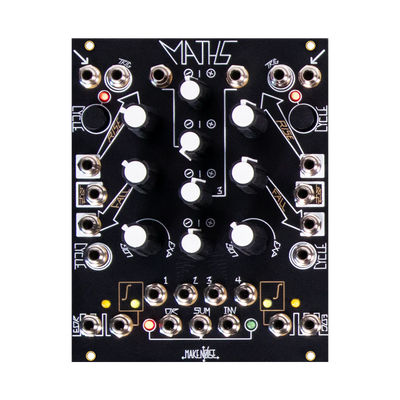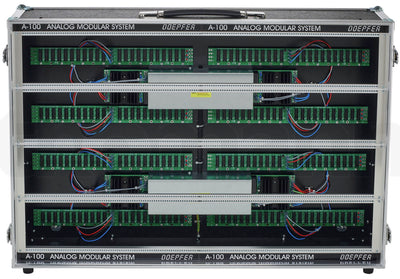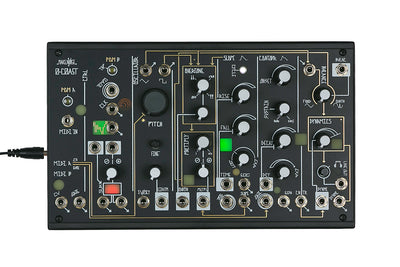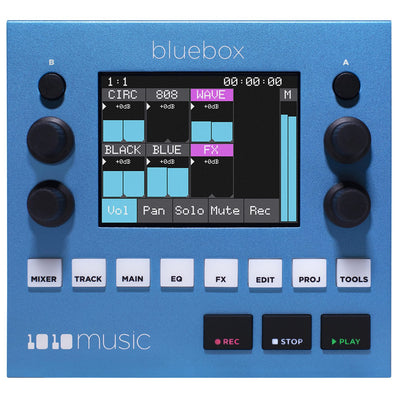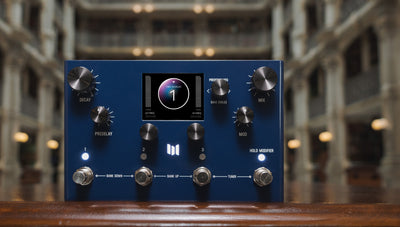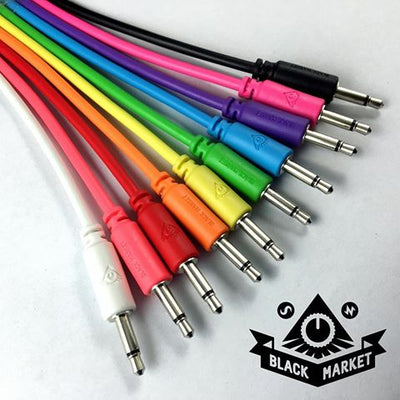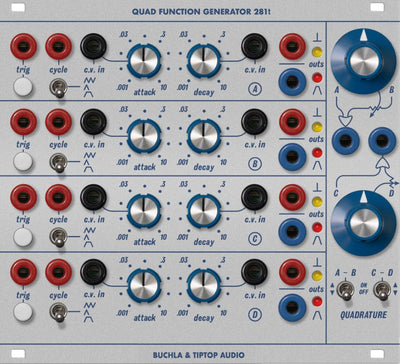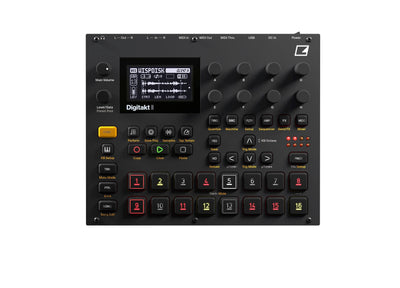The MiniMod Multi Burst Envelopes module generates variable length bursts of repeating envelopes that can change over time, with CV control of all functions.
The BURSTS control selects a "Burst Sequence" of between 1 and 40 individual envelopes. The envelope shape of a burst is chosen with the rotary switch, or it can be varied using an external CV, so that it is even possible to chose a different envelope shape for each individual burst in a sequence.
The width of the envelope (i.e. the attack and decay time) is varied with the P-WIDTH control and this can also be CV controlled as a sequence is progressing, so it is possible to vary the envelope speed of each individual envelope burst while a Burst Sequence is running.
The repeat time of individual bursts in a Burst Sequence is set with the LFO Rate control. The LFO rate can be varied with an external CV as a sequence is progressing, so the gap between envelopes can speed up or slow down over time. An external clock can also time the bursts in a burst sequence instead of, or in addition to the internal LFO. Bursts can also be manually incremented with the CLK push button.
The SLOPE control allows Bursts to start quietly and build in level to maximum, or they can start at full level and then reduce in level as the Burst Sequence progresses. In the centre position all Bursts are of equal level.
Module Width: 12hp
Module Depth: 26mm (Including power lead)
Current Usage: 28mA Positive, 12mA Negative
Overview
Sometimes one single envelope just isn't enough and we need some repeating envelopes. The Multi Burst Generator is a unique module that allows the easy creation of many different types of repeating envelopes, and these envelope bursts can increase, decrease or remain at constant level as the sequence progresses. It offers a huge amount of real time control over a burst sequence, including voltage control of all functions. We can select from 1 to 40 repeating envelopes and can increase or reduce the repeat speed, select how snappy or slow each individual envelope is and even change the individual envelope shape for each step while a burst sequence is running.
The internal LFO can be used to clock the Burst repeat time, or we can use an external clock instead and the clock does not have to be of constant time, irregular "time varied" clocks from modules such as our Dual RVG are also handled, it simply generates the next envelope in the burst sequence each time it receives a clock pulse or a press of the CLK button. And best of all we can use both the internal LFO and an external clock simultaneously to create interesting and complex polyrhythms.
There are two modes of operation, in one shot mode a burst sequence will proceed to the end, alternatively retrigger mode allows extra Trigger pulses to instantly reset and re-starts a new burst sequence.
There are two front panel status LED's, the LED on the left is illuminated when a burst sequence is in progress, and the LED on the right follows the level of each individual envelope generated.
The Multi Burst Envelopes design is collaboration between Allan Hall of AJHSynth and "Electric Druid" Tom Wiltshire, they combined their skills and many years of experience to create a compact Eurorack module that can generate complex envelope burst sequences that would otherwise require five or six individual modules along with some quite complex patching. It is one of those modules that you never knew you needed until you tried it, and then wondered how you ever managed without it!
The Multi Burst Envelopest is available with either a Black or Silver front panel.
Front Panel Controls
BURSTS control
This control selects the total number of bursts in a burst sequence, and this can be between 1 to 40 bursts. If one burst is selected then it functions in the same way a a regular AD envelope generator. We can also patch an external CV to the BR-CV Input to select the number of Bursts, in this case the Bursts control becomes an attenuator for the incoming CV.
P-WIDTH control
This control sets the width or speed of the envelope (i.e. the attack and decay time) and this can also be CV controlled by patching an external CV to the PW-CV Input and this can vary the individual envelope width, making it possible to vary the envelope speed of each individual envelope burst while a Burst Sequence is running. The width of each envelope in a Burst Sequence can be varied between 20mS and 2.5 seconds.
LFO RATE control
This controls sets the repeat time of individual bursts in a Burst Sequence, and it can be varied while a Burst Sequence is running. The LFO rate can also be varied with an external CV as a sequence is progressing, so the gap between envelopes can speed up or slow down over time. An external clock can also time the bursts in a burst sequence instead of, or in addition to the internal LFO. If the LFO-Rate control is turned fully anti-clockwise then the internal LFO will stop completely, and the LED will remain illuminated to show that it is waiting for another clock pulse to generate the next burst. Bursts can be manually incremented with the CLK push button, or pulses to the CLK Input, one press or pulse will advance the Burst sequence by one step until the total number of Bursts chosen with the Bursts control have been generated.
SLOPE control
If set fully counter clockwise the sequence of envelopes will start at a very low level and build up in level until the last burst is at 100% level, or if the control is set fully clockwise then Bursts will start at maximum level and then reduce in level as the Burst Sequence progresses, with the last burst being at around 3% of maximum level. In the centre position all Bursts are of equal level. If the control is set to the 9 o'clock position then the initial burst will be around 50% of maximum level and subsequent bursts will increase in level, with the last burst in the sequence being at maximum level. Therefore, with the Slope control we can set the relationship in level between the first and last bursts in a sequence.
The Slope parameter can be controlled with a CV to the SLP-CV input, and in this case the Slope control becomes an attenuator for the incoming CV. However, changes to the Slope setting do not have any effect while a burst sequence is running, they will not take effect until a new Burst Sequence is triggered.
ENVELOPE SHAPE switch
This eight way rotary switch selects the envelope shape for the individual bursts in a sequence, We have a choice of the following eight envelope shapes:
Sine wave, Log Down, Log UP, Expo Down, Ramp UP, Triangle, Ramp Down and Pulse.
The envelopes can also be selected by patching a CV of between 0V and +5V to the ENV-CV Input. The rotary switch is taken out of circuit and disabled when an external CV is patched in.
Envelope shape can be changed while a burst sequence is running, so for example if we selected a Burst sequence of eight steps then if desired we could select a different Envelope type for each individual burst.
TRIG button and TRIG Input
Pressing the TRIG pushbutton, or sending a short gate or trigger to the TRIG Input will start the Burst sequence. The Green LED on the top left will illuminate to show that a burst sequence is in progress, and it will go out after the last envelope in the sequence has decayed to zero.
MODE Switch
The MODE switch has two positions, ONE which is One Shot Mode, and RET which is Retrigger mode.
In One shot mode, once the TRIG button or pulse has been received then the Burst Sequence will progress right to the end and further presses of the TRIG button or pulses to the TRIG Input will be ignored until the end of the sequence, and only then will it re-arm and allow another Burst sequence to start.
In RET Mode the Trigger button and Input remain armed, so if a burst sequence has been started then if another TRIG is sensed then the current burst sequence will stop and a new sequence will be started.
CLK button and CLK Input
These allow the individual bursts in a sequence to increment by one for each pulse received. This can be using in addition to the internal LFO, so complex polyrhythms can be created.
GATE Output
Should more complex envelopes be needed then an external envelope generator can be triggered from the GATE output, and the Gate timing is controlled in the exactly the same way by the Bursts, P-Width and LFO-Rate controls.
Specification
Individual Envelope Length: 20msecs to 2.5 seconds
Internal clock rate: Off, 0.24Hz to 51Hz, or every 4.2 seconds to every 20msecs
Envelope waveshapeS: Sine, LogDown, LogUp, ExpoDown, RampUp, Triangle, RampDown, Pulse
Repeats: 1 to 40
Slope: bipolar, sloping up from 4%->100%, and sloping down from 100%->4%



